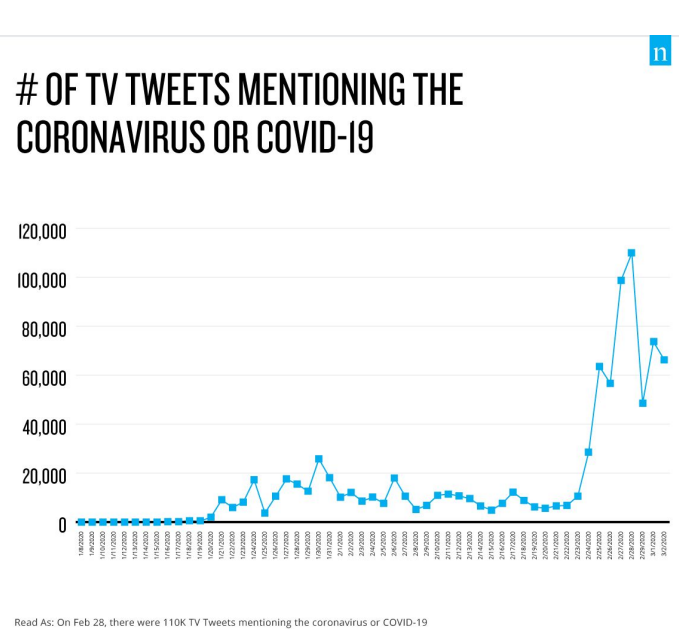Media Usage Expected to Rise During Crisis: Nielsen

Media usage is expected to increase as more Americans are forced to remain in their homes because of the coronavirus crisis, according to a new report from Nielsen.
Nielsen said that staying put can lead to to almost a 60% increase in the amount of content watched. “Considering that consumers around the globe are already leaning into the growing ray of content options and channels, a 60% increase is significant,” the report said.
Viewers will also be tuning in to get the latest news about the pandemic, said Nielsen, which notes big jumps in viewing already in other countries. For shut-ins, media can also be a way to pass the time, find solace and stay in touch with others.
Nielsen notes that media consumption in the U.S. was already at historically high levels. In its recent total audience report, Nielsen said that American spend nearly 12 hours a day with media. The same report found that three-fourths of consumers have been adding streaming subscriptions and TV connected devices, which give them even more media options.
To get an idea of how consumers' media habits change in a crisis situation, Nielsen looked at total TV usage during the major snowstorm of January 2016 and Hurricane Harvey in August 2017 and found that total TV usage increased significantly.
When a two-foot snowfall hit the New York area, TV usage that Saturday rose 45% from the previous Saturday and was 49% higher than the next Saturday after the blizzard.
During Harvey, total TV use rose 56% from the preceding period and was 40% higher than the period following the storm.
Broadcasting & Cable Newsletter
The smarter way to stay on top of broadcasting and cable industry. Sign up below
People working from home--something more and more companies are urging their employees to do in the face of the virus--can also lead to higher levels of media consumption.
Nielsen data suggest that people who work remotely Monday through Friday watched three hours more each week on traditional TV that people in offices. Remote workers spend more time watching on tablets and increase their amount of time listening to the radio.
Nielsen looked at what viewers were watching and found increases in feature films, news and general entertainment programming. Nielsen also found a 61% increase in streaming.
More recently outside the U.S., TV viewing in South Korea jumped 17%--or 1.2 million viewers--after early reports about COVID-19 in early February. In Italy, the Italian Joint Industry Committee reported a 6.5% increase in TV viewing in hard-hit Italy during the last week in February and a 12% jump in the country’s Lombardy regions--where severe quarantines were first put in effect. News consumption rose there.
The changes in media consumption brought on in reaction to the virus are meaningful to advertisers and media buyers. When consumers watch more, they might be willing to listen to brand messages. “But in an outcomes-based world where marketing ROI means converting brand messages into sales for services or products, these consumers may not risk leaving their homes to spend. Instead, they may opt to lean into the click-to-buy route,” the report said.
The COVID-19 virus is also likely to increase usage of social media, Nielsen said. According toe Nielsen Social Content Ratings, from January through February, there were 110,000 TV-related tweets mentioning either coronavirus of COVID-19.
“As COVID-19 continues to spread, this serious health threat has already shaken world markets and, no doubt, will affect the media ecosystem. Understanding, and potentially hedging ad and media investments could help buoy any shrinking margins, build awareness for public health messages and maybe even get consumers’ worried minds off a threat through the power of entertainment,” the report concluded.

Jon has been business editor of Broadcasting+Cable since 2010. He focuses on revenue-generating activities, including advertising and distribution, as well as executive intrigue and merger and acquisition activity. Just about any story is fair game, if a dollar sign can make its way into the article. Before B+C, Jon covered the industry for TVWeek, Cable World, Electronic Media, Advertising Age and The New York Post. A native New Yorker, Jon is hiding in plain sight in the suburbs of Chicago.

